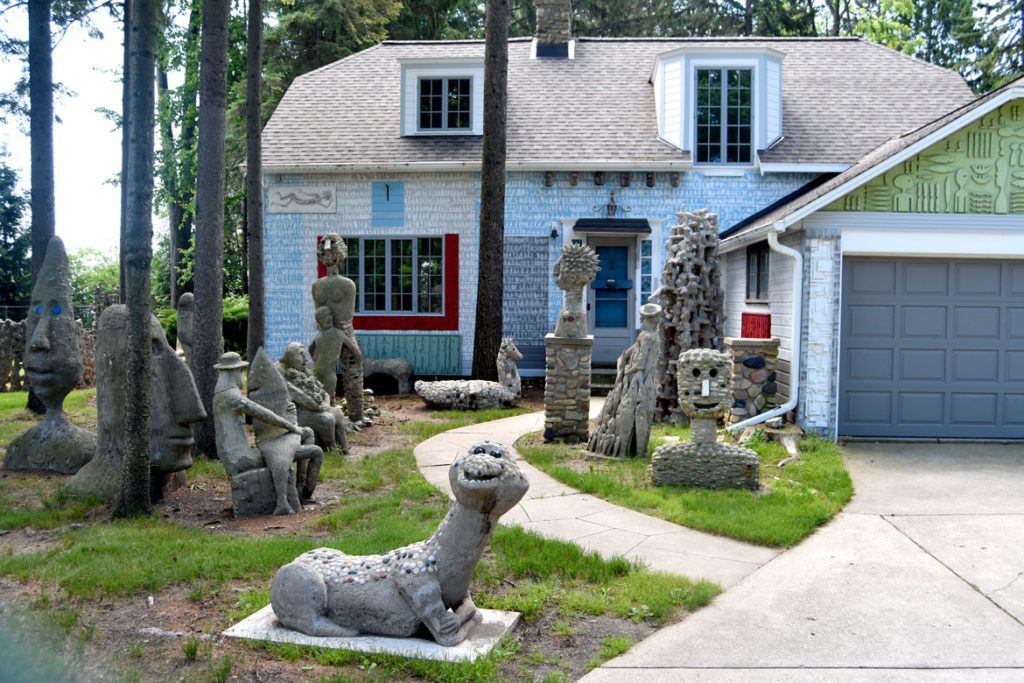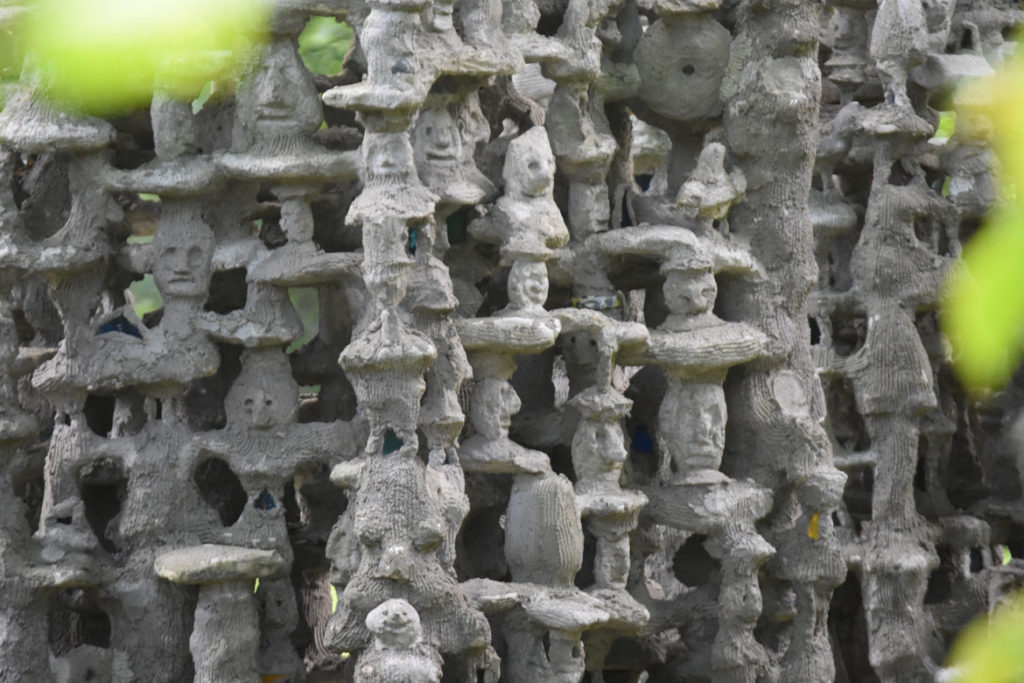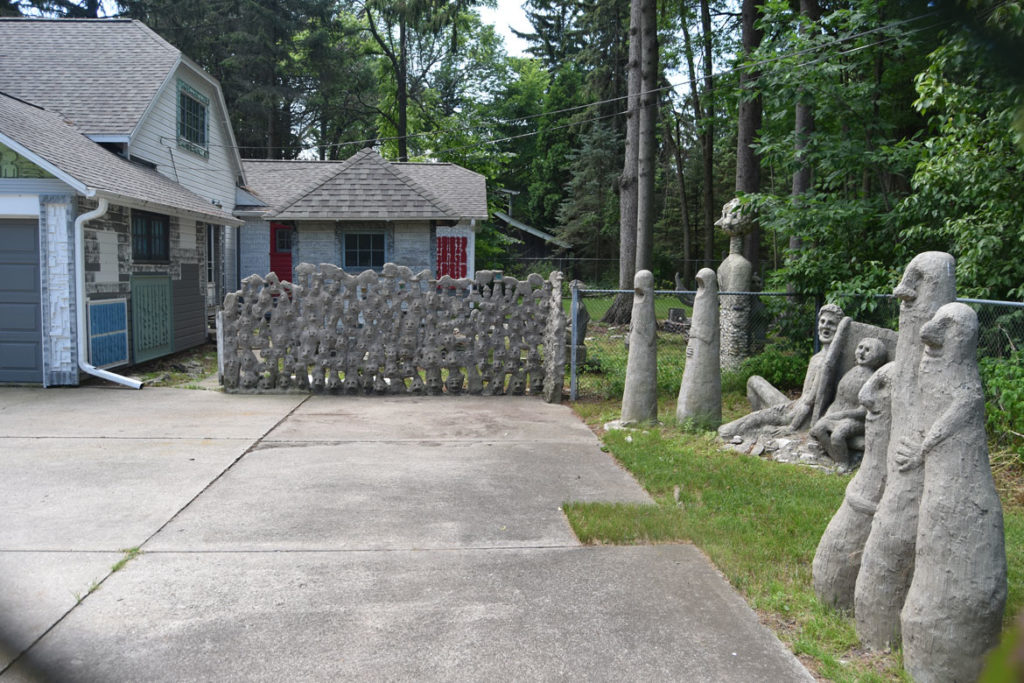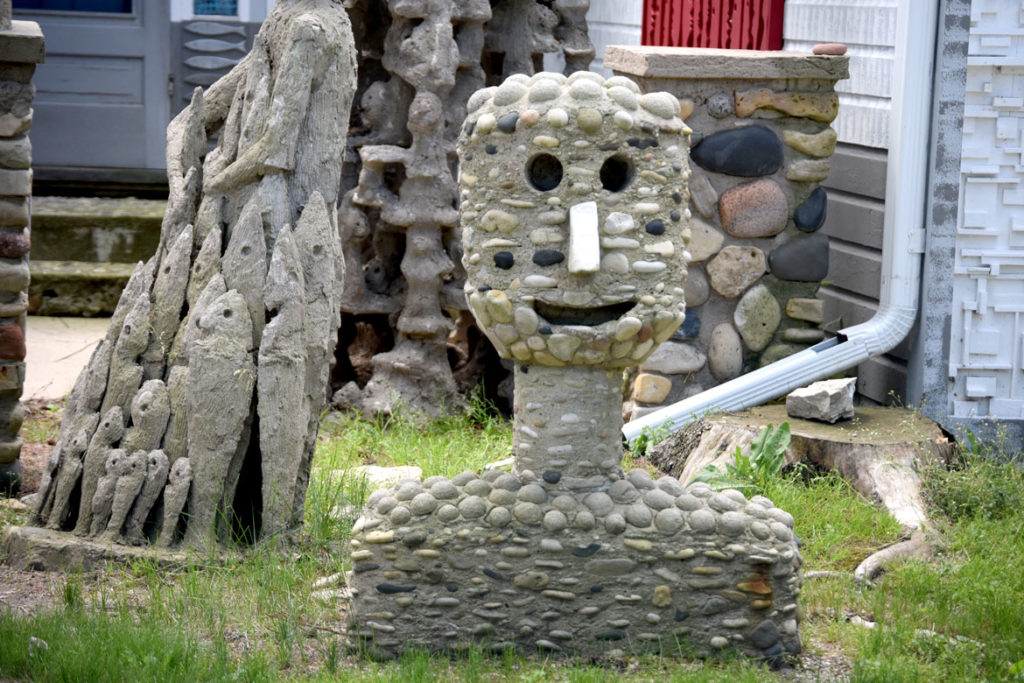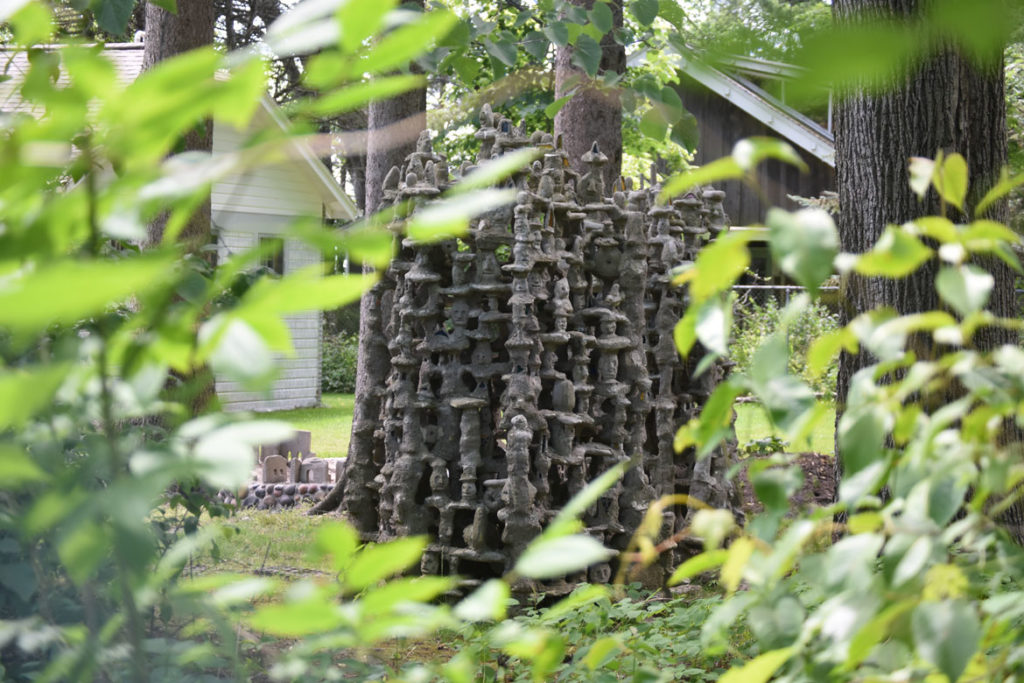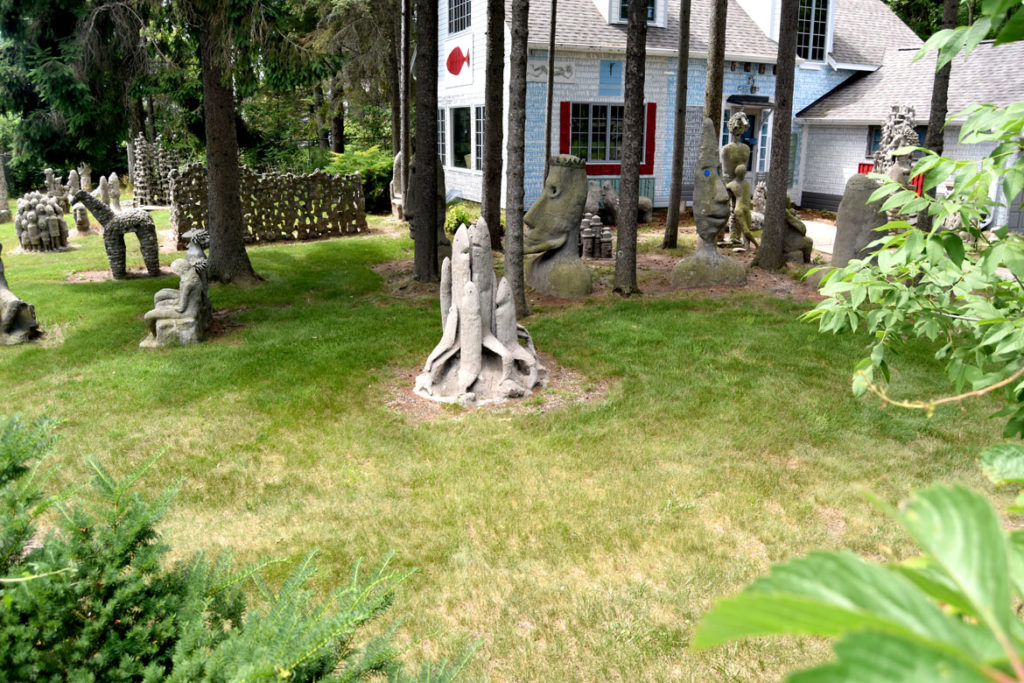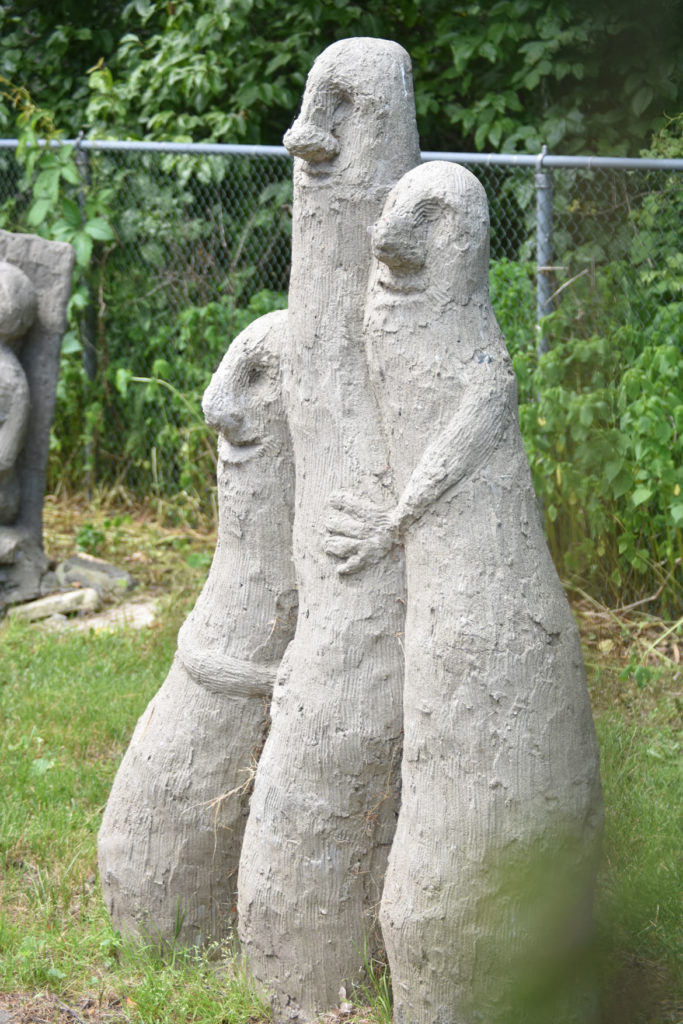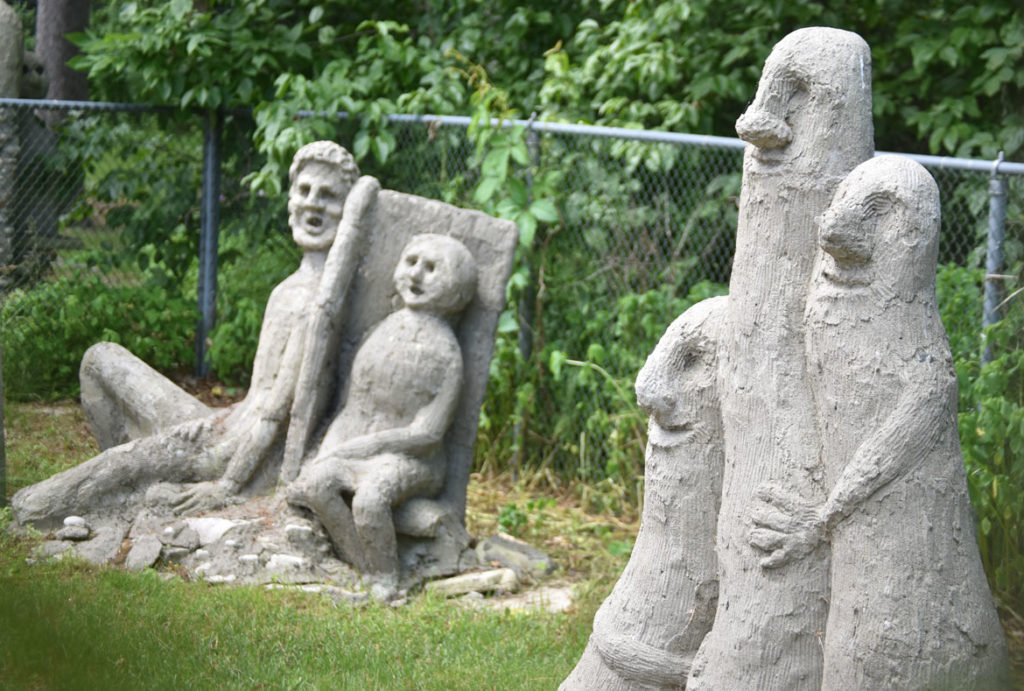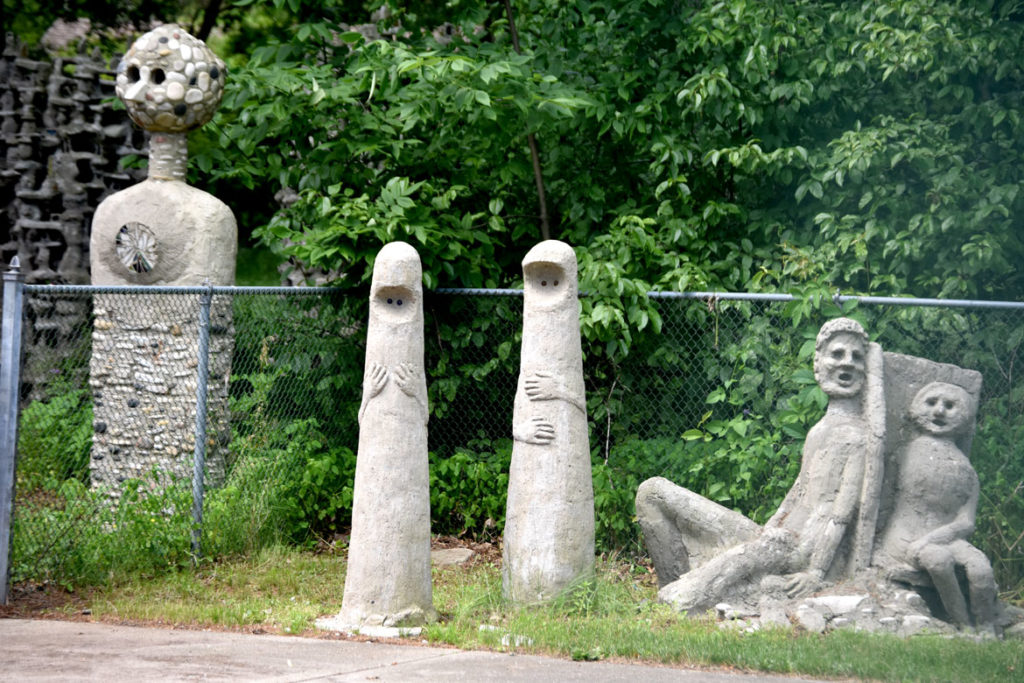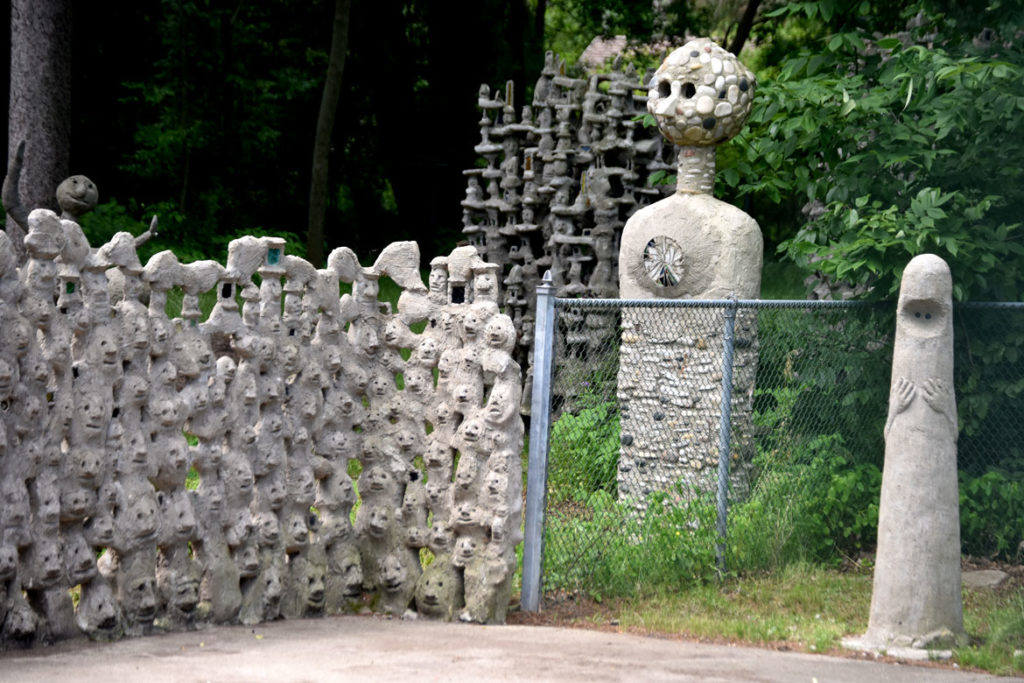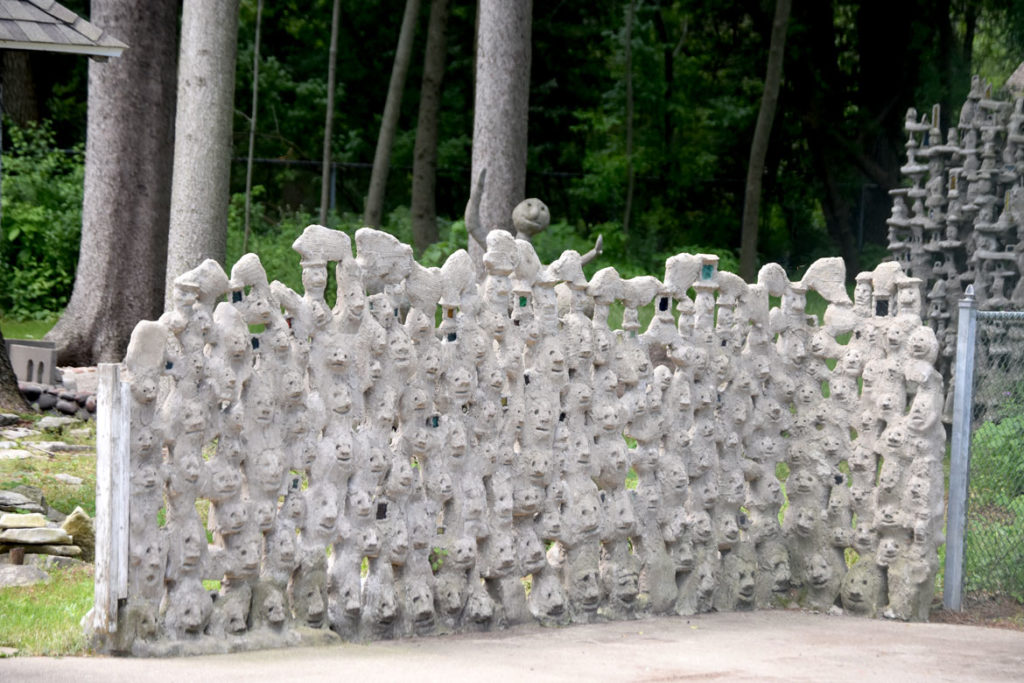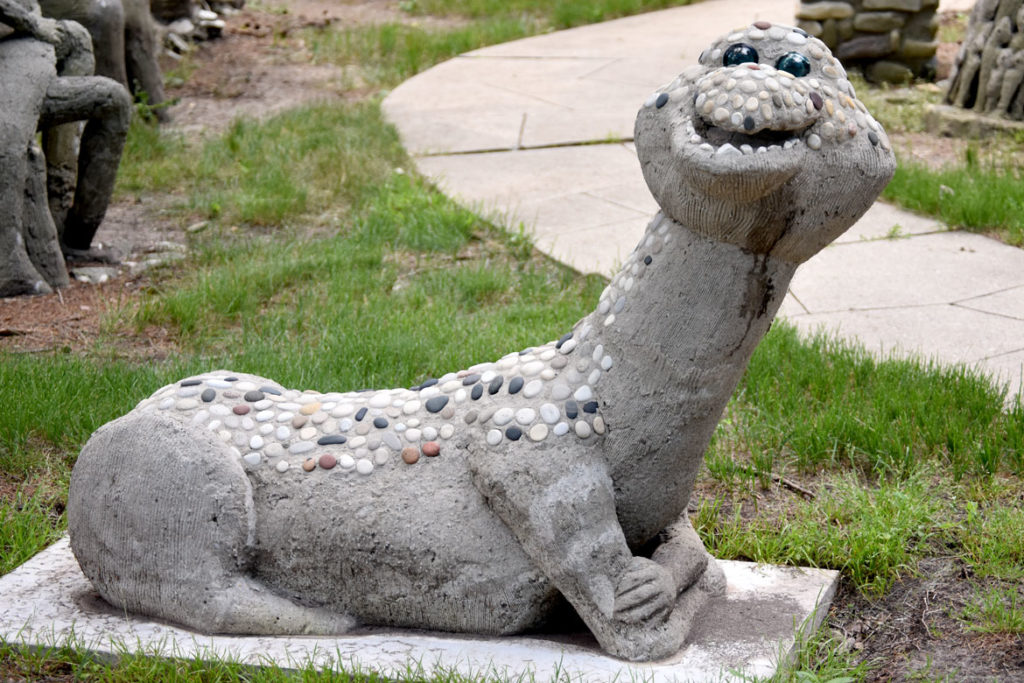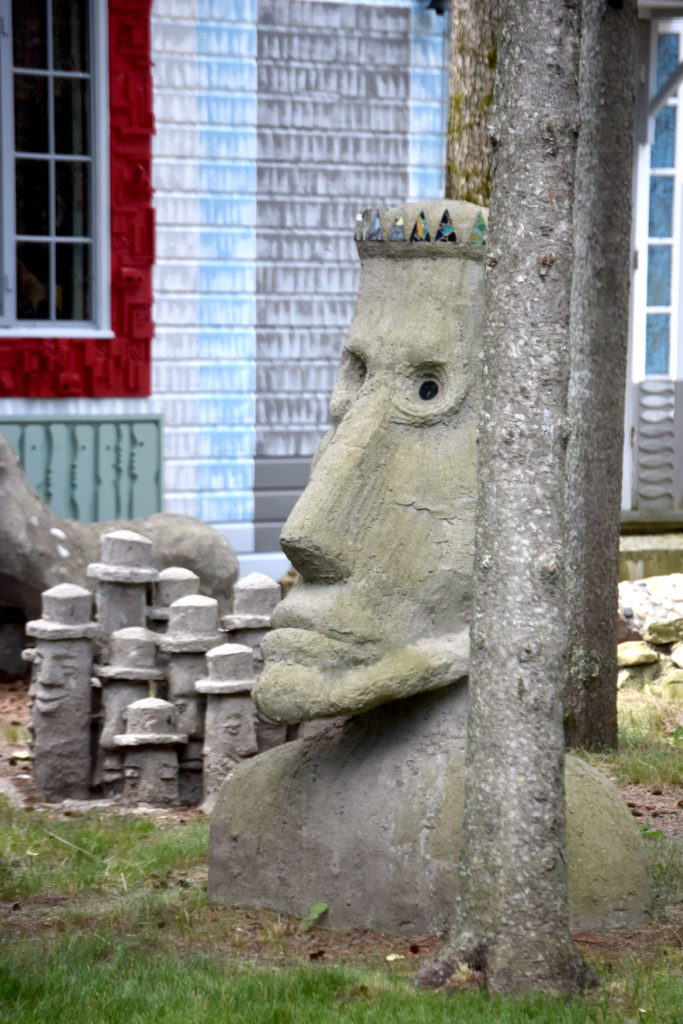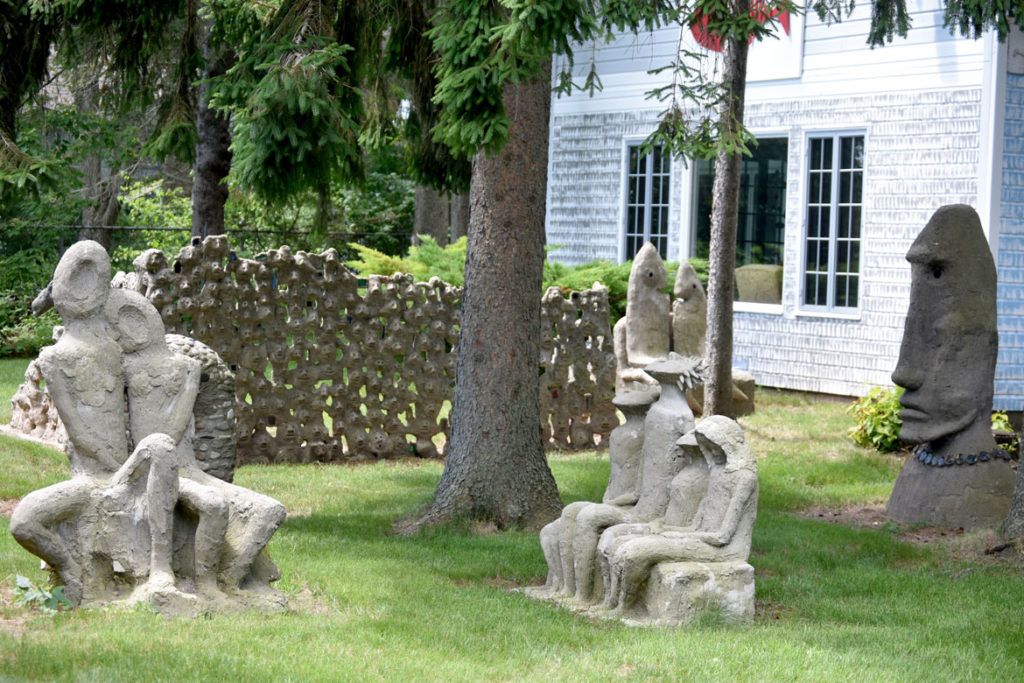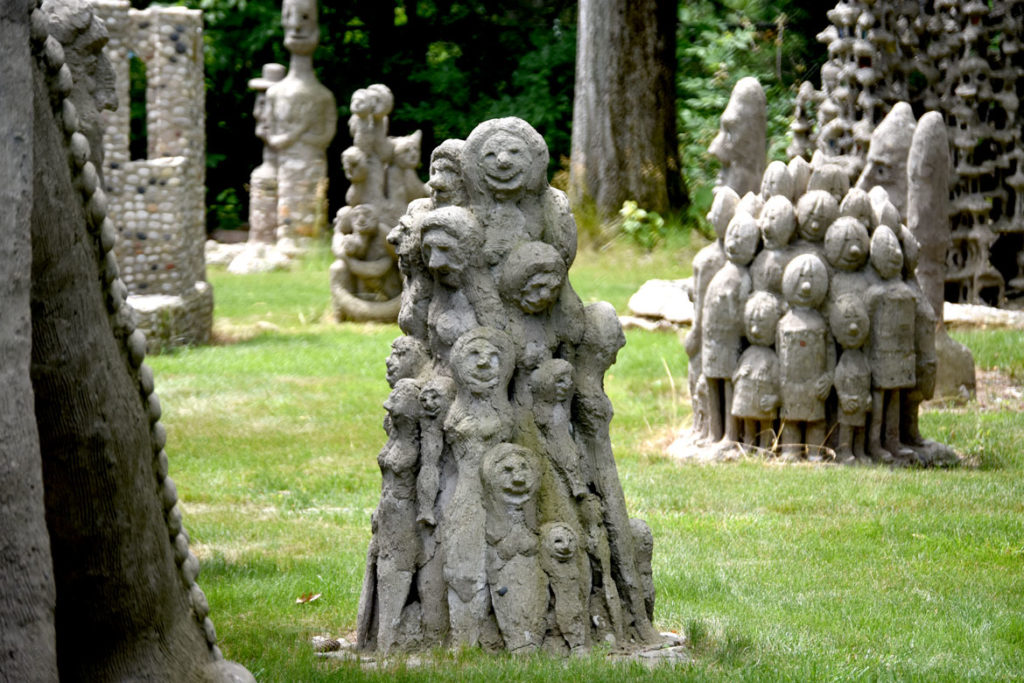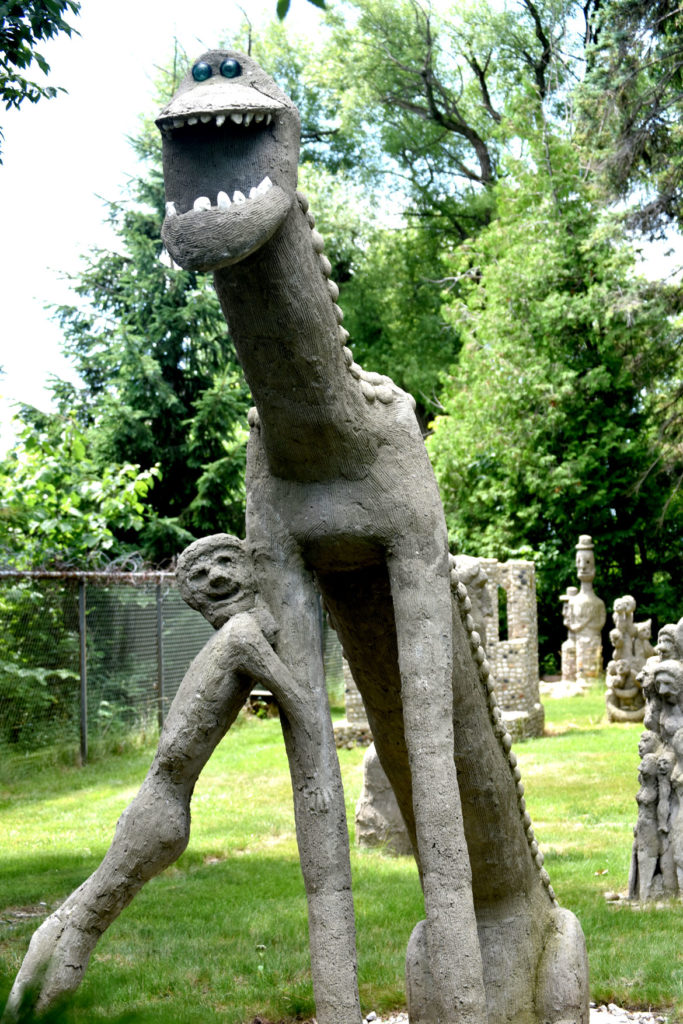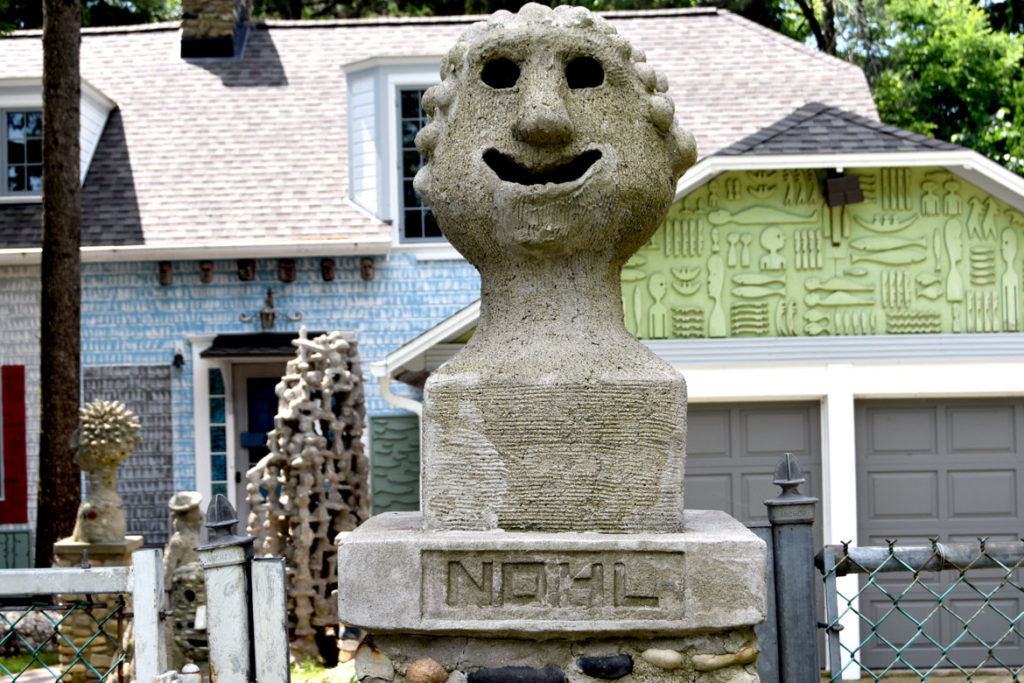“We wanted to believe a witch lived there,” Jim Stingl, a columnist for the Milwaukee Journal Sentinel, recalled not quite a month after the artist Mary Nohl died in 2001. He’d been one of the young folks who, beginning in the 1950s and ‘60s, were attracted by mysterious rumors to her cottage on the shore of Lake Michigan in a wealthy suburb just north of Milwaukee, Wisconsin. “We told and retold the stories we had heard. Her husband and son had drowned in Lake Michigan right outside her window, we were pretty sure. The statues on the lawn looked out over the water, waiting in vain for the pair to come home. And very possibly some of the sculptures in the yard used to be kids who were caught trespassing by the witch and turned to stone.”
During the 1960s and ‘70s, Nohl filled the tall grass and pines with more than 70 concrete sculptures that she crafted—monumental heads, fish, dogs, a 12-foot-tall dinosaur, ghostlike figures, a fountain, “ruins” of low walls and arched doorways. It was a world of creatures, smiling or somber, in gray stone with glass eyes that seemed to glow at night.

“Some people refer to me as a witch. I like that the best of all,” Nohl said in Andrea Lotscher’s documentary video “Mary Nohl: The Witch of Fox Point” from around 2000. She embraced it by embedding black pebbles in her doorstep to spell out the word “Boo.” But it wasn’t as simple as that. The rumors also stung. Nohl asserted in a 1996 interview that being called a witch was evidence of prejudice against “women who use tools.”
In fact, Nohl was a single woman (she sometimes found potential male suitors uncomfortable with her skills) and an art-school-trained modernist artist who drew inspiration from surrealism and folk art and the great lake.
“No amount of disorder will induce me to give up my front row seat on the changing moods of Lake Michigan,” Nohl wrote in a June 1972 newsletter, “the ice hills against the blue water in winter, and the afterglow of the sunsets in summer.”
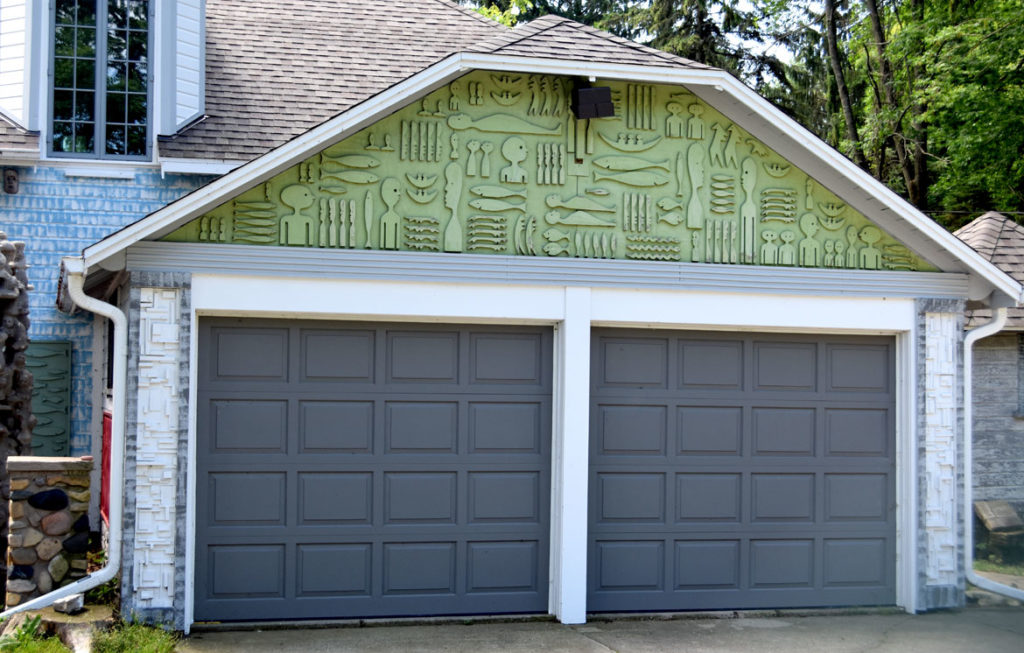
Noel’s wondrous home and much of her art and papers are now in the collection of the Kohler Arts Center in Sheboygan, Wisconsin, where she is the subject of the exhibition “Mary Nohl and the Walrus Club,” on view through June 2019. Her lakefront property and its enchanted garden were listed on the National Register of Historic Places in 2005, but efforts to open them to the public have been stymied by neighborhood opposition. At present the location is closed to visitors, but you can see much from the street. A decade and a half after her death, it’s one of the rare folk art environments created by a woman that has been preserved.
Nohl’s style can bring to mind Paul Klee, Alexander Calder, Louise Nevelson, Isamu Noguchi, Tove Jansson. She transformed her property into a visionary world of elemental stone beings, creatures of lake and land, gathered among ruins.
Help Wonderland keep producing our great coverage of local arts, cultures and activisms (and our great festivals) by contributing to Wonderland on Patreon. And sign up for our free, weekly newsletter so that you don’t miss any of our reporting.
A Cottage By The Lake
“I am sure my sculpture-filled yard had its origin in the gate posts,” Nohl wrote in her December 1991 newsletter to friends.
Mary Nohl was born in Milwaukee on Sept. 6, 1914. She was about 10 when her family built the prefabricated cottage at 7328 N. Beach Drive in the village of Fox Point that would become her home for much of her life and the inspiration and locus for much of her art.
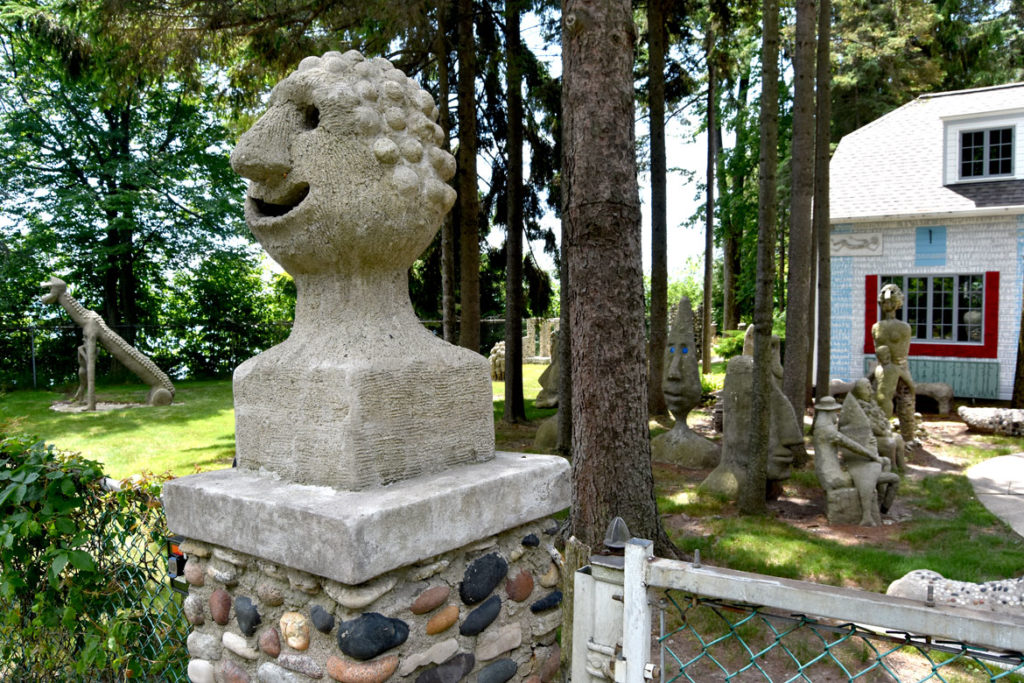
Nohl helped her father construct concrete gate posts for the new home’s driveway. They strained lake sand to mix concrete in a wheelbarrow and inlaid it with smoothed lake stones. “Sometimes when I go through the 7328 gates I remember how much fun it was when Dad and I were making the gate posts,” she recalled in 1991. “I was in grade school and I worked for dad for the magnificent sum of 25 cents an hour. The beach was all sand at that time and most of the right size stones had to be gotten from the lake. Dad knew all about wooden frames that moved up higher and higher as the gate posts grew bigger. The joy of being paid for having so much fun I have long remembered.”
The Nohls were one of the first families to erect a home in the area, on 1.37 acres of what until recently had been treeless farmland. Her father Leo was a wealthy and prominent Milwaukee attorney. (When Nohl herself died in 2001, she left her personal estate, valued at $11 million, to the Greater Milwaukee Foundation to fund artist fellowships.) Her mother Emma was a pianist and singer.
“Dad bought a collapsible cottage … and he had a truck bring it in,” Nohl recalled in the 2001 video “Mary Nohl: A Life’s Work” produced by Grassland Media for the Kohler Foundation. “The sides were all bolted together. And it had two porches on it and a room in the center. We came out for weekends. That was the beginning. Then we came out for summers, then we came out for all year and had a foundation.”
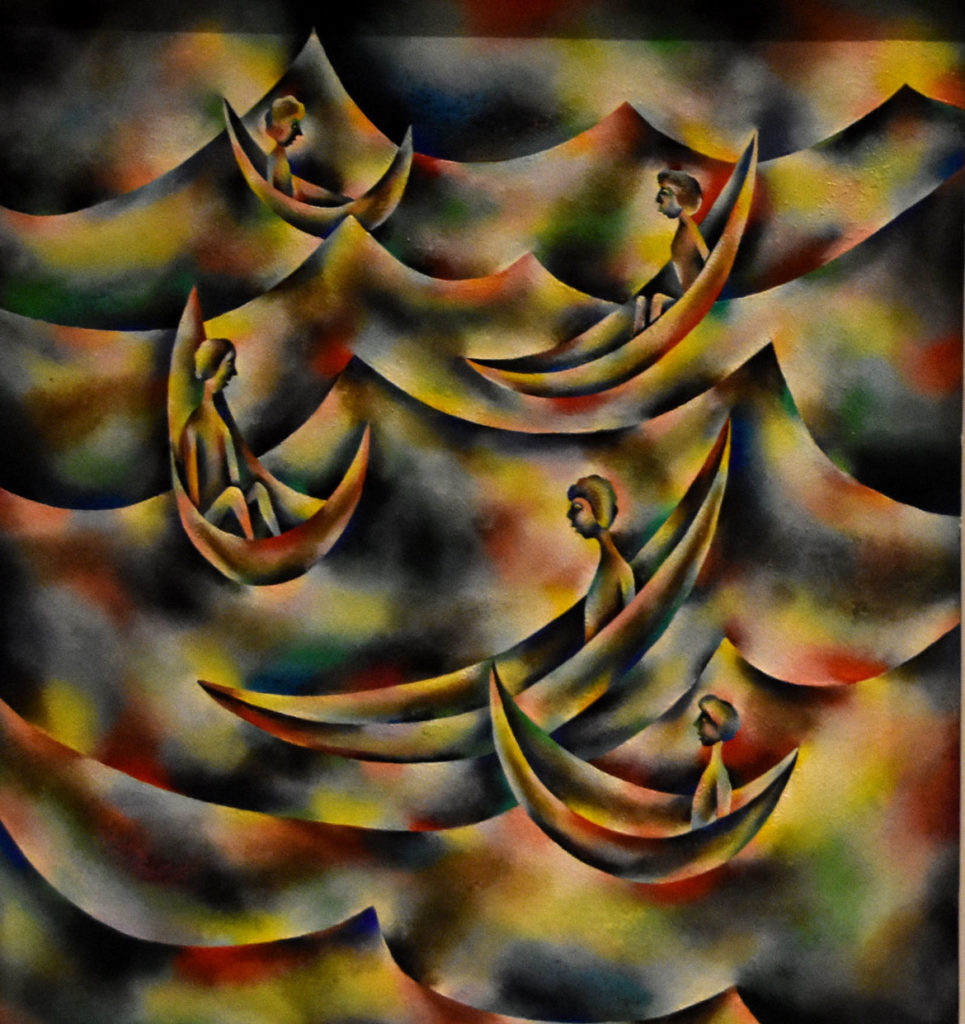
Nohl studied at the School of the Art Institute of Chicago from 1933 to ’37. After graduation, she pursed additional studies at Milwaukee’s Layton School of Art then back at the Art Institute to receive a teaching certificate in 1938. She taught in Baltimore and in junior and high schools in Milwaukee. (I’m relying for much of my information here on Leslie Umberger’s 2007 great book “Sublime Spaces & Visionary Worlds: Built Environments of Vernacular Artists,” which corresponded with a 2007 exhibition of the same name at the Kohler Arts Center.)
At the Art Institute, Nohl studied figure drawing and was fascinated by ceramics and clay. The school encouraged openness to traditions outside Western fine art and the city was a hotbed of surrealism.

Among Nohl’s teachers was Helen Gardner, who had first published her history tome “Art Through the Ages” in 1926. In subsequent decades, the book became one of the preeminent art history texts used by schools across the nation. Gardner’s approach surveyed traditions from around the globe and included media often excluded from the “fine arts”—textiles, pottery, metalwork, woodcarving, book-making. This wide-open exploration of creativity—which was continued by subsequent art historians at the school, including Kathleen Blackshear and Whitney Halsted—deeply influenced art making in Chicago and the surrounding region (including Milwaukee). Many artists schooled in this philosophy came to also passionately embrace folk art, vernacular signs, flea market finds, comics and commercial art—as can be seen in Chicago’s Hairy Who artists of the 1960s and ‘70s.
Chicago was also an active home to the surrealism (including an interest in the grotesque) that was a prominent strain of art across the country before New York School Abstract Expressionism came to dominate American fine art in the late 1940s. This interest was reflected by Chicago couple Lindy and Edwin Bergman (he was a metals company executive), who assembled a landmark collection of international surrealist art, including dozens of Joseph Cornell box masterpieces (now part of the collection of the Art Institute of Chicago).
Nohl took these influences with her when she gave up teaching (“It was very hard work and I was really too interested in doing my own art to continue teaching,” she told Debra Brehmer for a 1997 Milwaukee Magazine article) and moved back in with her parents at the Fox Point cottage around 1943. Her parents had expanded the home in the early 1940s and were now living there year-round.
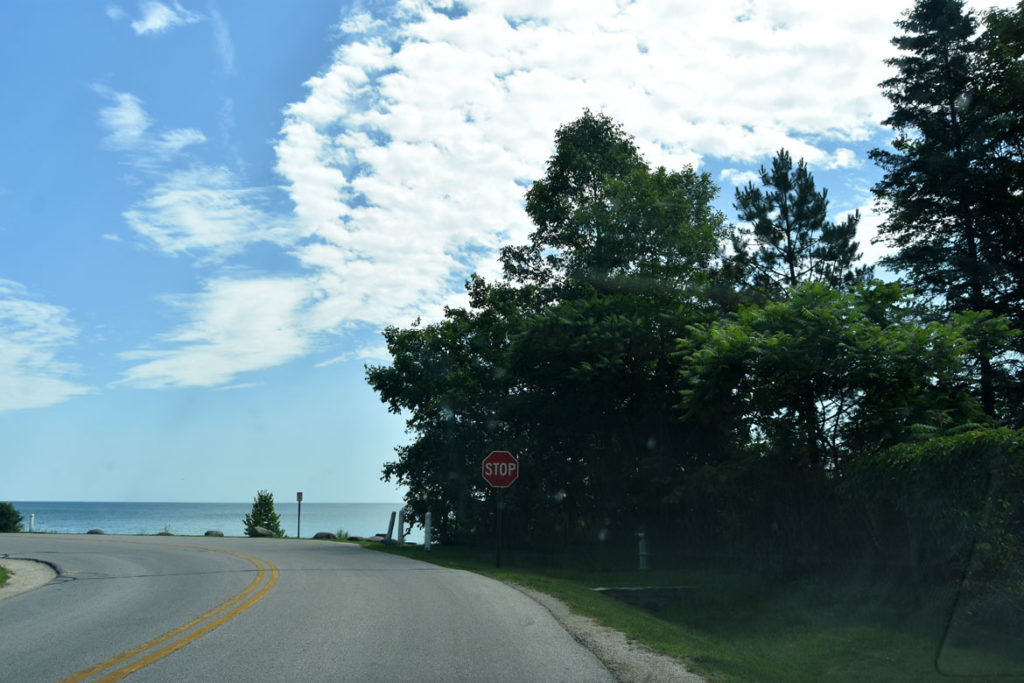
Lake Michigan, right outside their windows, was a focus for the family. In 1937, Nohl’s older brother Max had set a record by diving 420 feet deep in the lake. He patented an oxygen-helium respiratory apparatus in 1943. He continued to make headlines throughout his life for salvaging shipwrecks and deep-sea exploration.
Her brother’s adventures and Nohl’s passion for the lake inspired a comic Nohl made called “Danny Diver,” about a diver, mermaids, fish, an octopus, a swordfish and “sunken city.” Nohl drew it on and off for two decades as she and her brother tried (unsuccessfully) to get it published.
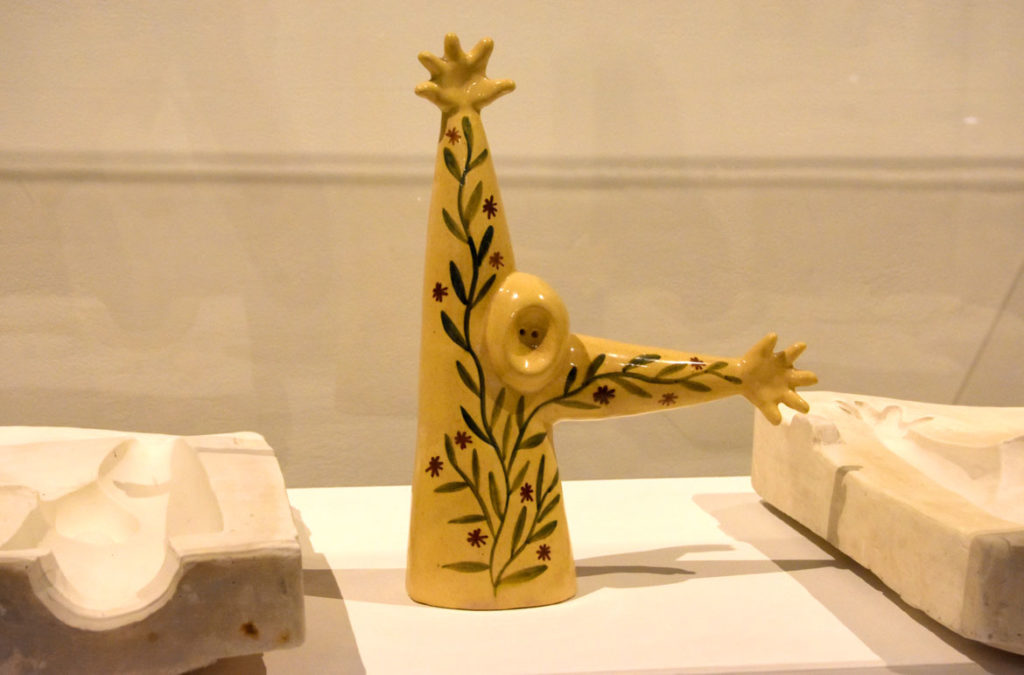
With her father’s backing, Nohl launched a production pottery studio at 5644 Green Bay Road, Milwaukee, in 1943. (“Dad built me the pottery,” she told Andrea Lotscher.) She made vases, lamp bases, ashtrays, tiles and ceramic figures for florists and gift shops. She closed the business around 1954, apparently when the building was demolished to make way for a new highway 43.
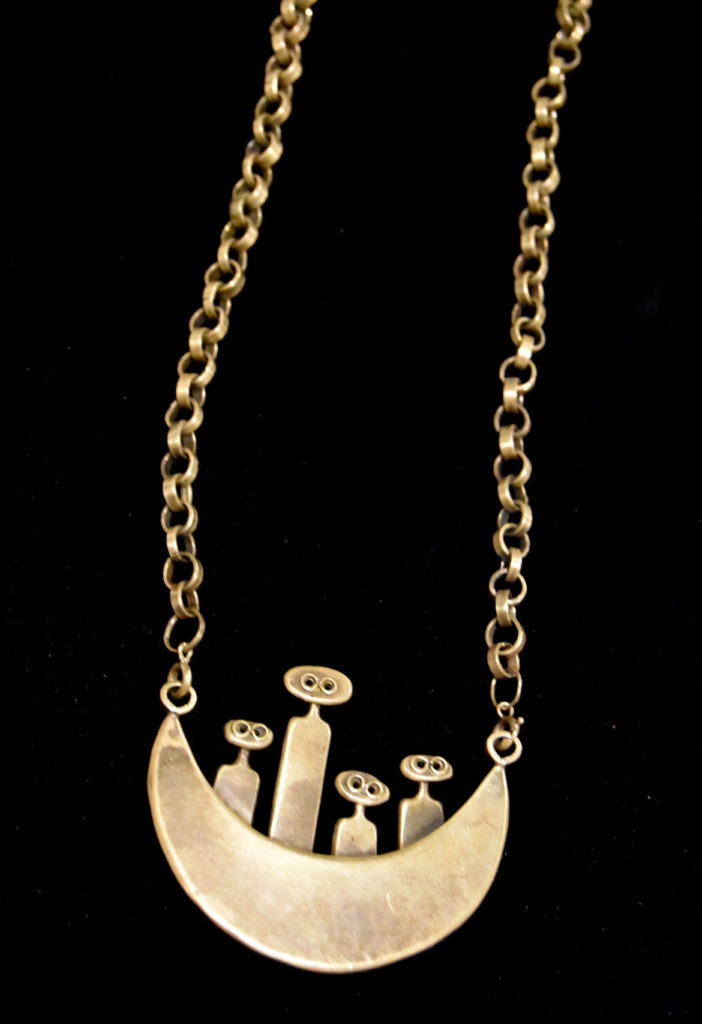
Instead, Nohl focused on her art—and home. Marine imagery, including people in crescent moon boats, became a lifelong motif. She filled scrapbooks with inspirations—surrealists Max Ernst and Joseph Cornell, Louise Nevelson’s assemblages, Fred Smith’s “Wisconsin Concrete Park,” Sam Rodia’s “Watts Towers” in Los Angeles, topiary gardening, modernist furniture, folk art. She also drew inspiration from her travels—across the United States, Mexico, Haiti, Jamaica, Cuba, India, Pakistan, Afghanistan, Europe, Egypt, Peru, Barbados, Trinidad, Canada.
Coming Into Her Own
“I’m really coming into my own at last—even if it does mean Mother’s departure,” Nohl wrote in her diary in 1963. “I get such satisfaction … now that I’m the boss.”
Nohl’s brother Max and his wife were killed by an auto crash in 1960. Her father died the following year at age 84. Her mother’s health was declining so she moved into a nursing home around 1963 and subsequently died in 1968 at age 93. This left Nohl alone in the lakefront home—and liberated.
“I wasn’t dependent upon my income because dad left a heap [of money],” she told Andrea Lotscher. So she had the freedom and the means to focus on reshaping her world into her vision. She wrote in her June 1968 newsletter: “My very best guest room has just been converted into a tool room—mostly machine tools up from the basement—band saw, circular saw, drill press, silver soldering, welding, stone-cutting equipment.”
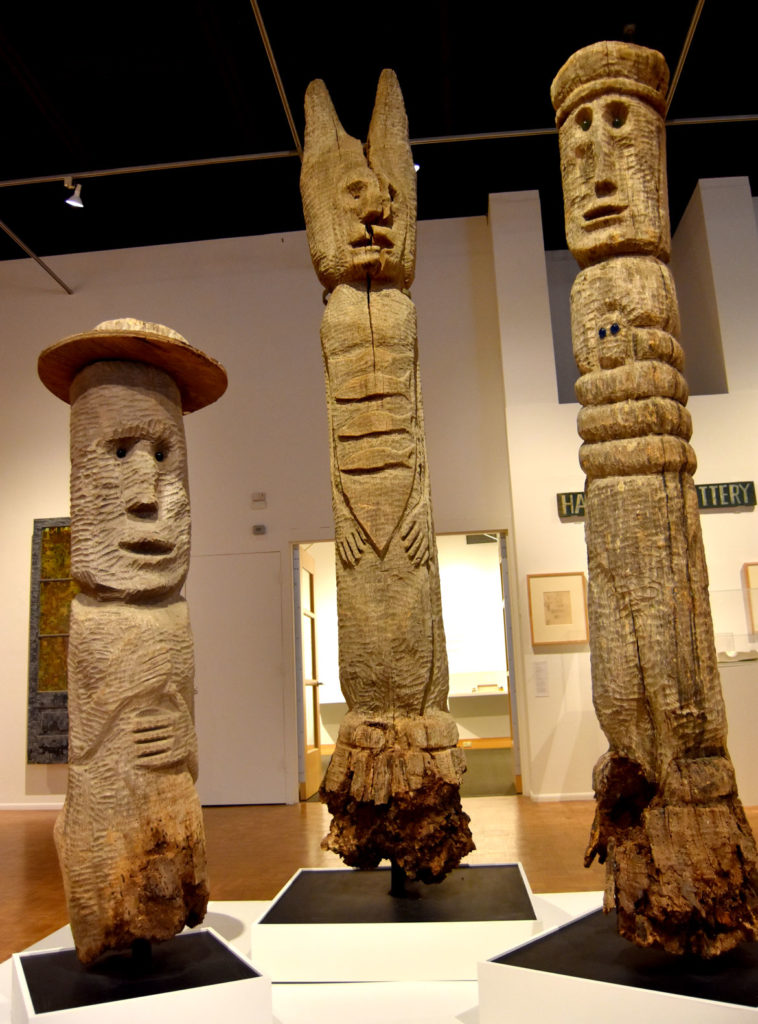
Nohl made chainsaw sculptures from logs. She crafted driftwood figures, windmills, glass chimes, spinning sculptures, pebble paths, a “lullaby blue” wooden plank fence featuring silhouettes of smiling people and fish. She melted down her mother’s silver service to craft jewelry. She repainted the house’s furniture, carpets and walls. She drew wiggly mazes and made surreal paintings in watercolors and oils. She assembled figures out of sticks and chicken bones. She fashioned hanging sculptures out of eggshells and tin.
“I never liked buying stuff, so I always made what I could out of what I had around,” she said in the 2001 video “Mary Nohl: A Life’s Work.” “…I never threw anything away.”

Nohl wrote in her June 1974 newsletter: “The upstairs tub was suffering from scouring powder abrasion, so a man came to make an estimate. The estimate never arrived and in the interval I decided a pink nude in painted blue water would be a lot more fun. I wouldn’t do that to a new tub, but it smoothes out the old tub to perfection. So now there is always someone in the tub, and I’ve adjusted to sitting on a reasonable facsimile of myself, who is in some ways even more beautiful.”
Nohl wrote in a 1965 journal that it was “getting sort of like a carnival around here—with color and sound.”

Her curious additions to the property attracted admirers and gawkers and vandals. “In the 1960s, her garden collection became a kleptomaniac’s dream as local teenagers and fraternities seeking the perfect prank stole hundreds of pieces of her prized sculptures and unique collectibles,” according to her Dec. 23, 2001, obituary in the Milwaukee Journal Sentinel. “One of her wooden sculptures was set afire, and vandals would throw rocks at her windows. To combat such vandalism, Nohl would blast a foghorn at the looting youths. ‘This usually scatters the marauders,’ she said in a 1979 Milwaukee Journal story. ‘But now they’ve gotten used to it, and will often yell, ‘Let’s hear the foghorn.'”
Her skirmishes with trespassers and vandals consumed her for years. Police visited her home frequently to try to nab troublemakers. In Nohl’s June 1970 newsletter, she reported replacing a window with a wood panel with a hole in it that she fired blanks through to scare off “these characters [who] sometimes enter the yard. There is no sound of lead whistling through the trees but the explosion and flash of the blanks have been very effective.”
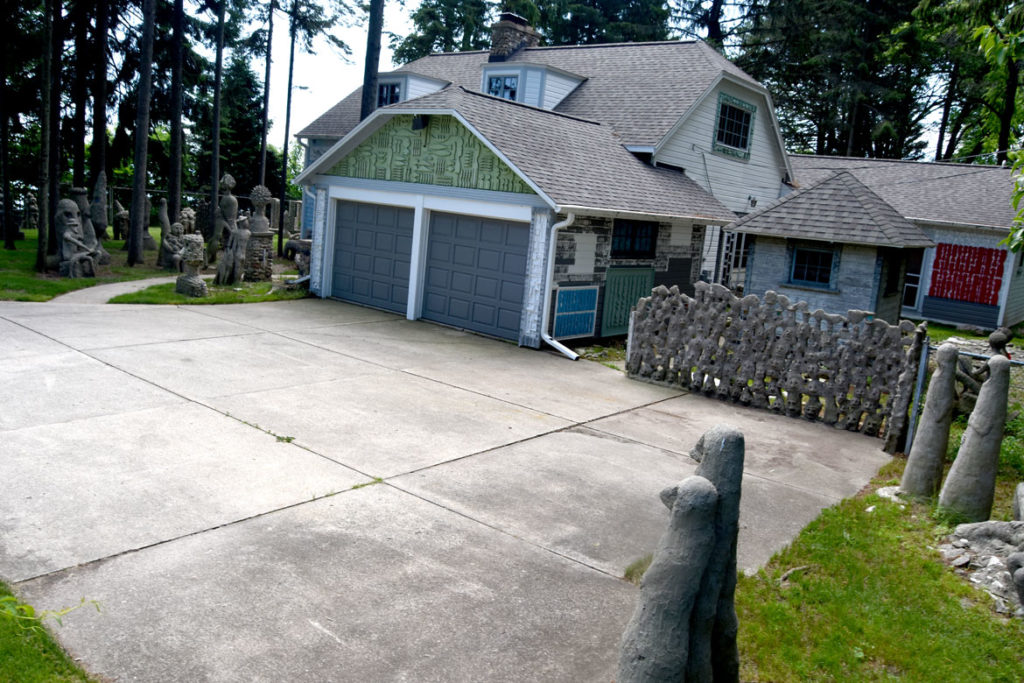
Wear from the weather and vandalism (“One 8-foot windmill was stolen last fall,” she wrote in the June 1970 newsletter) prompted Nohl to switch from wood to concrete for her outdoor sculptures. In 1970, she replaced the wooden fence with a 6-foot-tall chain-link fence topped by barbed wire.
Nohl wrote in her December 1973 newsletter: “I was awakened early one Sunday morning to the sound of a crackling fire, and relieved to find that the fire was burning a driftwood figure in the front yard—and not the house. This particular sculpture has been a target for the kids for years – about 15 feet high and so encrusted with paint and so dried in the sun, that the burning was like a series of explosions. Called the poor, overworked police who sat in three squad cars outside the fence and watched it burn. [Dogs] Sass, Basil and I sat inside and watched from the front window with the aid of a beer. All that was left were two 10-foot pipes anchored in cement, and before the last sparks had drifted off I had plans for my largest cement animal [the 12-foot-tall dinosaur]. The two pipes conveniently became the two front legs of a less destructible cement creation.”

“To build these pieces, Mary first develops a rough idea on paper,” Debra Brehmer explained in her 1995 master’s thesis “The Handcrafted Universe of Mary Nohl.” “She then makes armatures out of metal rods, old pipes, fence wire or tin and fills in the forms with stones she collects by the beach in an old red wagon. She applies concrete in sections, from the ground up, allowing each to dry for two or three days before adding the next. She often combs or trowels a texture into the wet medium and adds subtle decorative flourishes, such as beach stone, marbles or reflector eyes and ornamental bits of pottery or tile.”
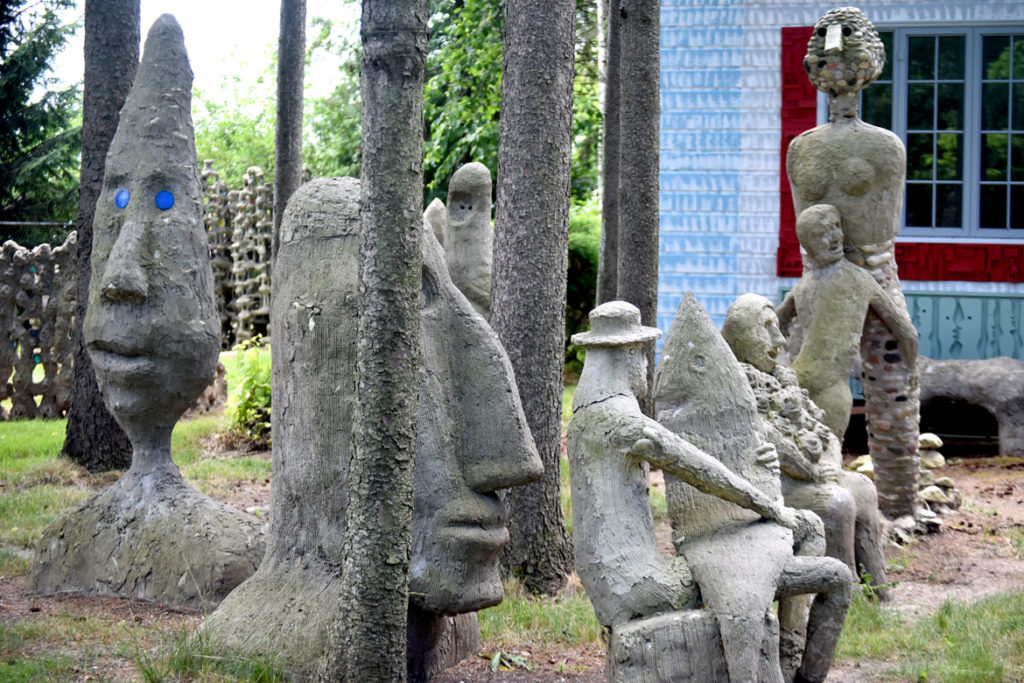
Nohl filled her yard with concrete sculptures of monumental heads, of a man embracing a fish sitting on his lap, of a smiling person hugging a crowd of small smiling people, of a couple of fish sitting chatting on a bench, of a tiny stone village, of that 12-foot dinosaur. By the time she died in December 2001 at age 87, she had sculpted some 70 of them.
“I was known as the witch,” Nohl told Andrea Lotscher, “but it didn’t interrupt my fun at all.”
Help Wonderland keep producing our great coverage of local arts, cultures and activisms (and our great festivals) by contributing to Wonderland on Patreon. And sign up for our free, weekly newsletter so that you don’t miss any of our reporting.
